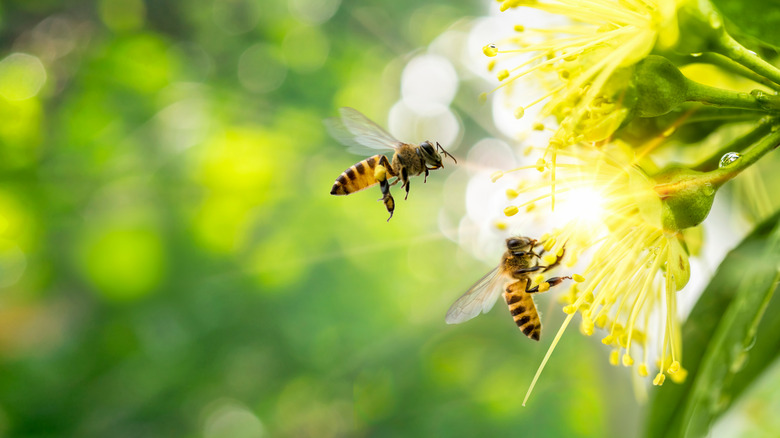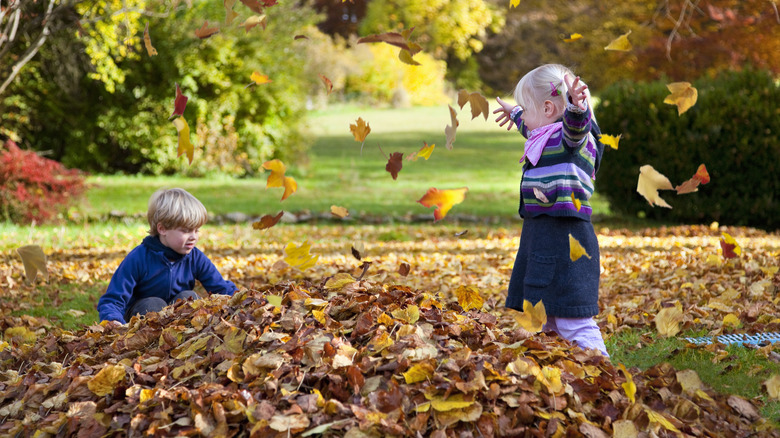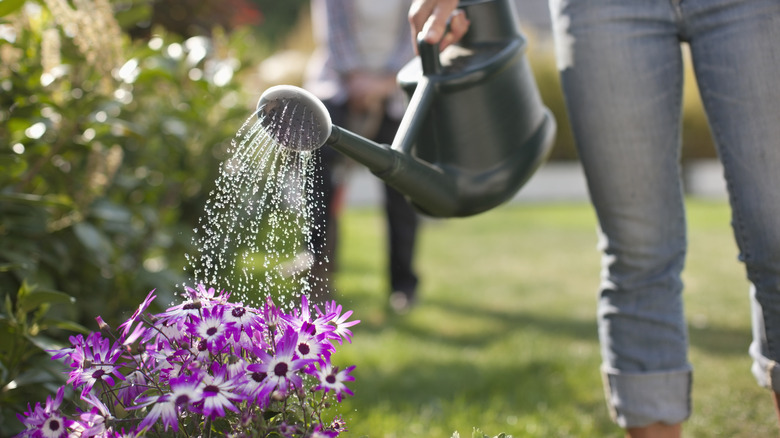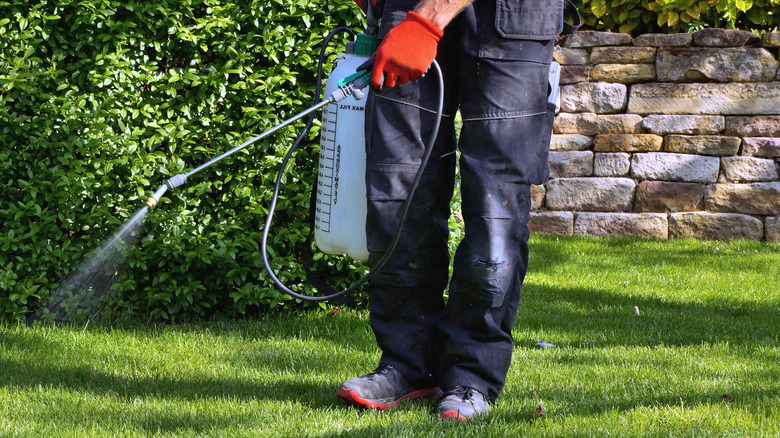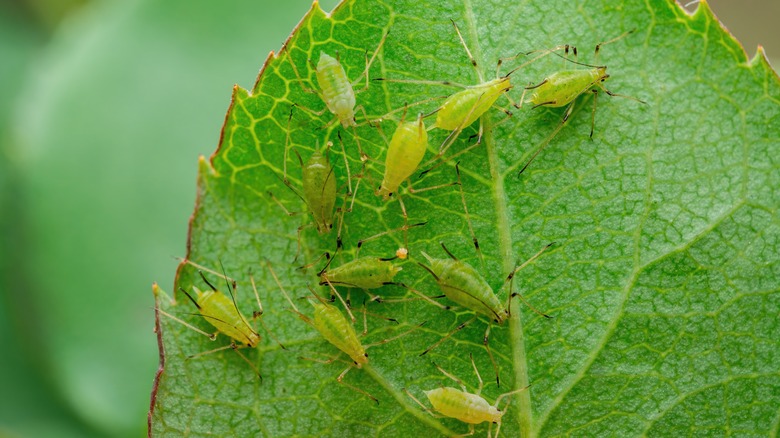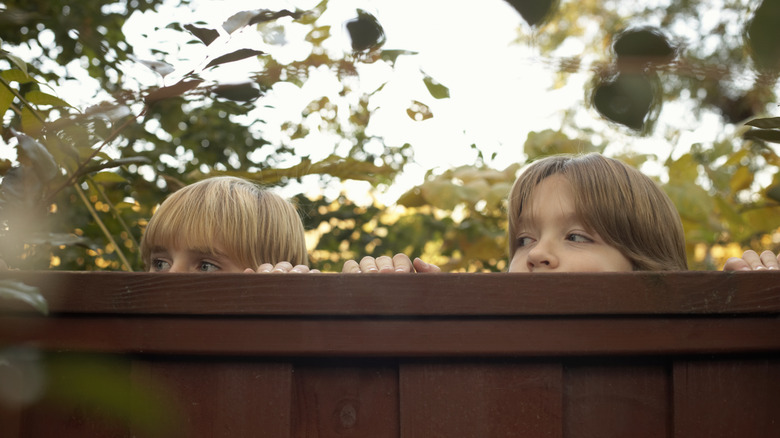How To Attract Good Insects Into Your Yard And Garden, According To An Expert
Good insects may seem like a misnomer to some. Insects, after all, are often seen as pests by those yet to be indoctrinated into the fascinating world of gardening. But it's true: Whether you plan out and execute an elaborate garden of crops to be harvested at the end of a growing season or simply add a few flowers here and there around the yard, the value of insects in this habitat remains an understated but crucially important part of the ecosystem.
Gardener's Path notes that a host of beneficial insects can be found in the garden, and their role in your household space is essentially one of defense. While there are countless bugs that spend their days munching on your tomatoes, flowers, and other plant life, beneficial insects like ladybugs, spiders, and soldier beetles eat these nuisances. Bees and birds are also helpful additions to any garden because they play an essential role in the pollination process and add color and a jolt of life to your space.
In an exclusive interview with House Digest, Dr. Charles van Rees, a professional naturalist and conservation biologist who blogs at Gulo in Nature, lays out five key steps that a homeowner can take to improve the composition of their garden space through the attraction and care of beneficial insect species.
Provide habitats to encourage different beneficial species
Anyone seeking to cultivate a more inclusive garden environment will need to consider the habitats that the space provides. In the same way you need rooms and amenities in your household, the insects you're hoping to attract to your garden require a certain set of features and amenities, too. "Refuges like tall grassy areas can increase the number and variety of ground-based predators like carabid beetles and wolf spiders patrolling your garden for harmful pests. Meanwhile, woodpiles, rock walls, and leaf litter can lead to more pollinators like bees, moths, and butterflies," Dr. van Rees explains.
A variety of different species and the creative use of various habitat options are needed to create a thriving and healthy garden space that will attract predators, pollinators, and more. Dr. van Rees says, "Greater variety means more places for helpful bugs to live their lives. Many species actually need to live in different types of habitats at different life stages, so having it all in one place will increase their numbers."
Have a variety of plants
Similar to how having different habitat materials will attract insects, growing a variety of different types of plants can serve the same function. "Try setting aside different parts of your garden to have different types of plants," Dr. van Rees suggests. "For example, you could have one dry section where you use rocks or gravel and drought-resistant plants, or a wildflower corner, grove of raspberry bushes, or patch of tall grass."
It's also worthwhile to consider a variety of specific flowering plants interspersed throughout the garden. "Having different kinds of flowering plants, especially ones like mint, catnip, and lavender that make lots of flowers and bloom for long periods of time, will bring in helpful pest-control agents like wasps, which hunt caterpillars," Dr. van Rees notes.
A variety of plants makes for a thriving natural habitat that increases the population of beneficial insect species. Similarly, some plants can help return nutrients to the soil and give your growing space the best possible chance to provide continuous resources and a beneficial growing medium over the long term.
Reduce your use of pesticides and herbicides
Pesticides can be a valuable stop-gap solution when fighting an infestation of aphids, caterpillars, and other harmful insect species. However, relying on pesticides and herbicides can create a long-term problem in your lawn care and garden maintenance routine.
Dr. van Rees explains, "Even if they are applied to affect a target pest or weed, harmful chemicals quickly build up in the bodies of other non-target animals, many of which are helpful. The higher you get in the food web, the more of these chemicals builds up, and it can do serious harm to animals."
For example, spiders eat a considerable number of unique pests that make a haven in your garden. But the more they eat (after using a pesticide), the larger the effect will become on your population of spiders. Ultimately, you may kill off the spider population before eliminating all of the pests in the space, "In other words, every time one animal eats or feeds on another, it can build up more of these harmful chemicals. This ultimately means that helpful pest-control bugs — the useful predators in your garden — will be the first to disappear when you start using chemicals," notes Dr. van Rees.
Keep it local
Local plants and animals will always be a preferred addition to a yard over importing foreign species. "Generally, it's better for your garden to make habitats that will attract new native species to your yard, rather than try to have new ones brought in a box," Dr. van Rees suggests. Ecosystems are fragile, and the introduction of a species that is not native to your community or perhaps even your neighborhood can offset the balance of this critical plant infrastructure.
Many people will certainly know that ladybugs act as important predators when dealing with an explosion in your garden's aphid population. But, Dr. Rees notes that imported ladybugs (or other predatory species designed to help tame an out-of-control pest problem) can eventually lead to more problems down the road. He says, "Wherever possible, avoid bringing in foreign beneficial insects that aren't native to your area. While insects from lacewings and ladybugs to praying mantises are readily available to purchase online, they can be really harmful to your garden ecosystem. In a couple years, they can outcompete and wipe out the diverse team of beneficial insects hard at work on your land, and replace it with a less effective alternative."
Make it a neighborhood affair
Finally, Dr. van Rees suggests that a neighborhood that works together to improve the overall makeup of the community's beneficial insect population can produce a thriving environment that is consistently productive and doesn't experience overwhelming outbreaks of new or surging pest infestations. He notes, "If you make great habitats for wildlife, they're much more likely to show up, but you can greatly increase your chances if the surrounding landscape is hospitable to them. Try chatting with your neighbors about making some of the changes mentioned above; the larger the area of habitat you're providing, the greater abundance and variety of beneficial bug species you can keep around."
Like-minded individuals flock together in communities that surround sports teams, beneficial climates and landscape features that promote wellness and comfort, important waterways, and much more. Speaking with neighbors in your immediate surroundings can help you develop a community-minded project of landscape rejuvenation that acts like a powerful magnet, attracting a wide swath of beneficial insects that will help control populations of pests and maintain a healthy and productive garden environment for the long term. In the same way you are hoping to establish a thriving insect community in your yard, working together with your neighbors can build a larger, community-centric space that is great for everyone involved, even the insects!
